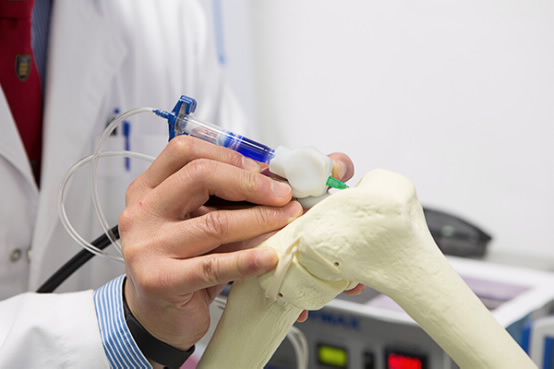Biopen Changes the Rules for Orthopedic Surgery

ACES doctors give a demonstration of the opportunities for healing offered by the new biopen. Courtesy of the University of Wollongog.
Latest News
December 13, 2013
Additive manufacturing (AM) is an interesting technology to follow not just because of what it offers, but because of how it can inspire innovation. Rapid prototyping means inventions and upgrades enter into production more quickly, and sometimes researchers can even riff off the technology to develop new products using AM elements. The 3Doodler is one example of this in action, even if it isn’t the sort of development that will save the world.
Perhaps inspired by the 3D drawing device, scientists at the Australian Research Council Centre of Excellence for Electromaterials Science (ACES) have developed an AM biopen that allows surgeons to draw live cells directly onto an injury, decreasing recovery times and assisting with the regrowth of bone and cartilage.

The biopen works in a very similar fashion to the 3Doodler, except that it is filled with bioregenerative hydrogels made from a living cell material suspended in a biopolymer such as alginate (seaweed extract), and protected by an outer layer of the same material. Just like in regular AM, the surgeon builds up layers of the material with each layer being cured by a low-powered ultraviolet light that’s attached to the biopen.
Upon completion of the surgery, the cells begin to multiply and divide into new nerve cells, muscle cells or bone cells, and will eventually help form new musculature and healthy bone. Along with the cells, the biopen can also contain growth factors or medicines that assist in healing the target area.
“This type of treatment may be suitable for repairing acutely damaged bone and cartilage, for example from sporting or motor vehicle injuries,” said Professor Peter Choong, Director of Orthopedics at St Vincent’s Hospital Melbourne and the Sir Hugh Devine Professor of Surgery, University. “[ACES] research team brings together the science of stem cells and polymer chemistry to help surgeons design and personalise solutions for reconstructing bone and joint defects in real time.”
Not only does the biopen operate following AM principles, its swift development and production was also partially the result of 3D printing. Prototypes were built via AM, and the inspiration for the device came from research into growing new knee cartilage from stem cells on 3D printed scaffolds to treat cancers, osteoarthritis and traumatic injury.
Below you’ll find a short video about the biopen.
Source: University of Wollongong
Subscribe to our FREE magazine, FREE email newsletters or both!
Latest News
About the Author
John NewmanJohn Newman is a Digital Engineering contributor who focuses on 3D printing. Contact him via [email protected] and read his posts on Rapid Ready Technology.
Follow DE





